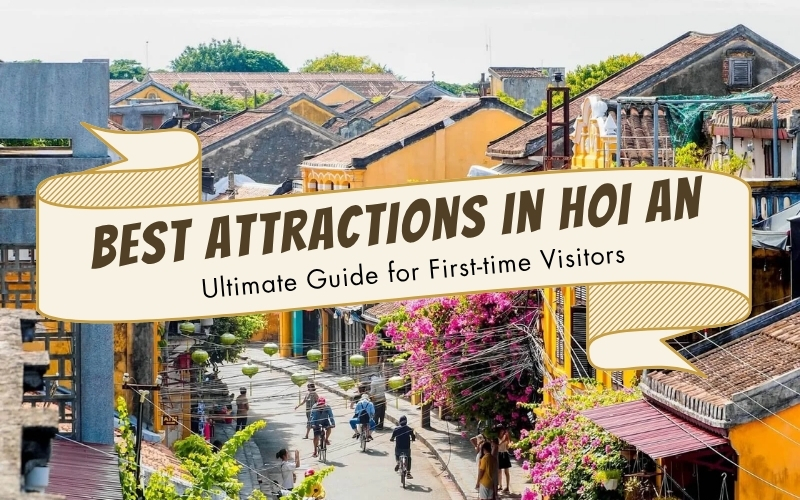
Ever wondered what makes Hoi An one of the most popular destinations in Vietnam? What are the places that truly capture its timeless charm? Discover the top tourist attractions in Hoi An to fully experience the beauty and historical depth of the town. The list of famous places in Hoi An below will reveal to you the attractions that are considered the soul of this ancient town. Let’s meet a poetic and historical Hoi An through the article below!
Why Hoi An should be on every traveler’s bucket list?
If there’s one place in Vietnam that can completely capture the heart of anyone who sets foot in it, it’s Hoi An, a UNESCO World Heritage town with a quiet and poetic beauty. As soon as you set foot in it, you’ll feel like you’ve stepped into another world, where time slows down, the streets are lit up with shimmering lanterns and there’s something beautiful to explore on every corner.
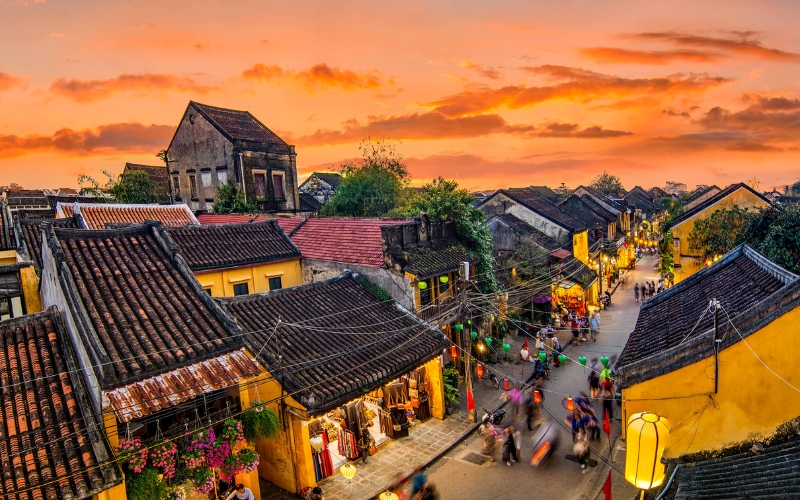
The enchanting sunset in Hoi An
Located along the central coast, Hoi An is not a big, bustling city like Hanoi or Ho Chi Minh City. It’s smaller, more peaceful and, frankly, much more charming. You’ll see ancient yellow houses with moss-covered tiled roofs, colorful entrances and narrow streets filled with small shops, cafes and street food vendors. And when the sun goes down? The whole town lights up with lanterns, giving you a magical feeling that you’ll never forget. Traveling to Hoi An is not just a simple sightseeing trip but also an opportunity for you to experience the rich cultural and historical values, along with delicious specialties.
One of the things I like most is that it is very easy to explore here. Famous tourist attractions in the area such as craft villages, beaches, coconut forests, … are all quite close to each other. You can walk almost everywhere or rent a bike and cycle through the rice fields or down to the beach.
What are the must-see attractions in Hoi An?
Hoi An ancient town
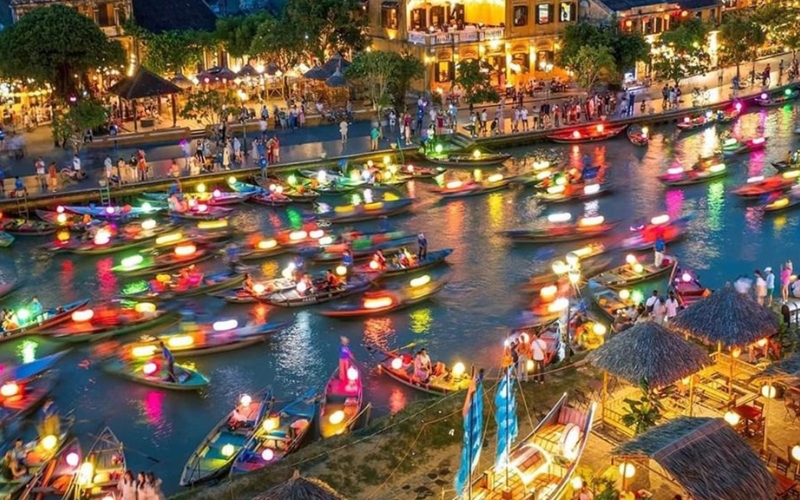
Hoi An Ancient Town by night
Address: Right in the heart of Hoi An, within walking distance of most hotels.
Opening hours: Open all day, but ticketed heritage sites (such as ancient houses, pagodas and museums) are only open from 7:30 AM to 5:30 PM.
Entrance fee: Free to visit, but $5 to enter 5 of the 22 preserved monuments.
Recognized as a UNESCO World Heritage Site since 1999, Hoi An Ancient Town is the heart and soul of the city, and is arguably the most iconic tourist attraction in Hoi An. Wandering through centuries-old houses painted in pale yellow, intricate wooden shops and quiet alleys, you will feel as if time has stopped. Every night, the streets of Hoi An are lit up by thousands of colorful lanterns, and you will find yourself lost in a magical world of light, where time seems to stand still. The lanterns are not only decorative but also represent the cultural and historical significance of this ancient trading port.
If you are lucky enough to be here during the Full Moon Lantern Festival (14th or 15th of every lunar month), the electricity in the Old Town will be cut off and replaced by warm lantern lights, traditional music and flower candles floating on the river. During the festival, you can also buy flower lanterns and release them into the river, as a symbol of your hopes and prayers. It is truly magical – one of those moments you will never forget.
Local tips:
- Wear comfortable clothes and shoes as you may have to walk a lot or on uneven stone paths.
- In my experience, the best times to explore and take beautiful photos are early morning (before 9am) and afternoon (after 4 PM). You can avoid the crowds and the hot sun during the day, the soft morning light and the beautiful sunsets will definitely make for some great photos.
- Don’t just explore the streets, buy tickets to other popular attractions. This is a great way to learn more about the town’s cultural heritage.
Japanese covered bridge
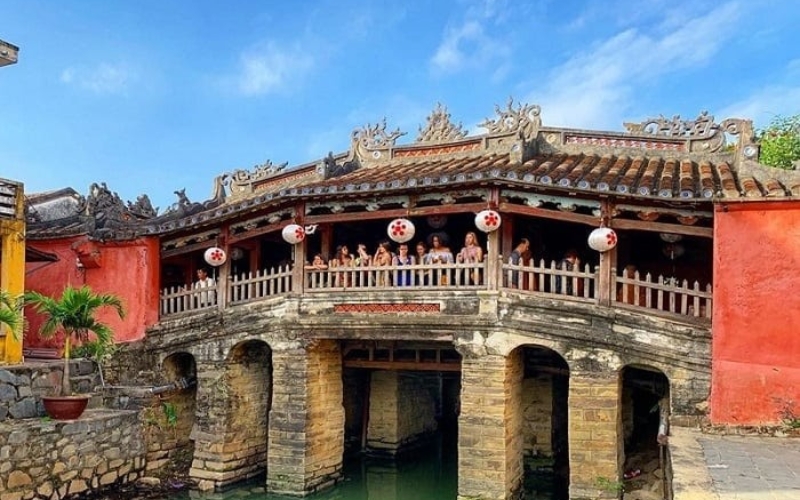
Japanese Covered Bridge, the timeless symbol of Hoi An
Address: Nguyen Thi Minh Khai Street, Hoi An Ancient Town
Opening hours: 7:00 AM – 9:00 PM daily
Entrance fee: Included in the Hoi An Ancient Town entrance ticket (approximately $5)
Built in the early 17th century by Japanese merchants, the Japanese Covered Bridge is one of the most iconic tourist attractions in Hoi An, renowned for its stunning architecture and historical significance. The bridge is made of wood on 18m long stone pillars, with a curved roof spanning the creek that flows into the Hoai River. The entire bridge is intricately carved, blending Japanese, Chinese and Vietnamese architectural styles. And yes – it is extremely photogenic!
Today, the bridge remains one of the most popular tourist attractions in Hoi An, attracting visitors who want to admire the details or take a photo in front of this timeless architectural work. I recommend coming here early in the morning (before 8 AM) if you want a peaceful, uncrowded moment to take photos, or at dusk, when the lanterns start to light up, giving it a magical warmth.
Local tip: If you are lucky, you may catch a traditional performance or local vendors nearby selling lanterns as souvenirs, but avoid coming at noon when the area is crowded with tourist groups.
The old houses
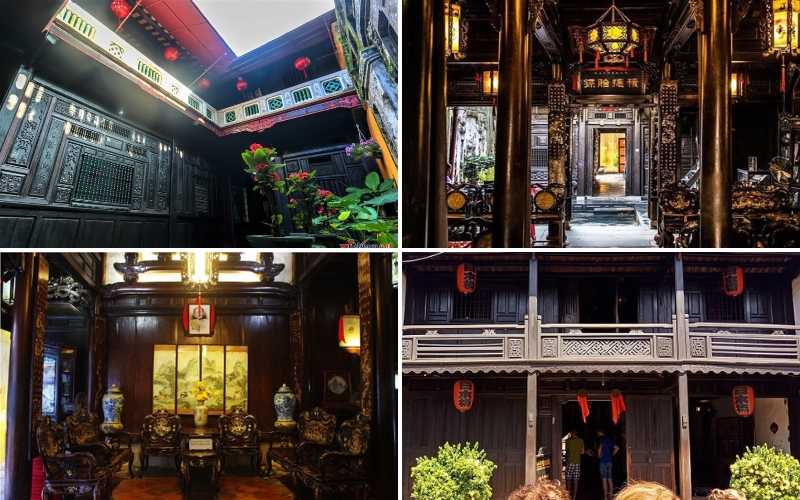
Some of the most popular old houses in Hoi An
Opening hours: 8:00 AM – 5:30 PM
Entrance fee: Included in the Hoi An Ancient Town entrance ticket (approximately $5)
After hundreds of years, the ancient houses in Hoi An still retain their beauty and special appeal, attracting thousands of tourists every year.
- Tan Ky Old House: Tan Ky Old House, one of the ancient houses over 200 years old, is a living museum of Hoi An’s time and culture. The special feature of this ancient house is that there is not a single nail. All the columns and beams are built with mortise and tenon joints. Currently, there are many valuable ancient objects in the ancient house. Visitors to Tan Ky Old House are very interested in the stall displaying traditional Hoi An souvenirs, Confucius cups or beautiful paintings, …
- Phung Hung Old House: Phung Hung Old House was built in the 1780s and has retained its original architecture to this day. The house has a more majestic and spacious design than other old houses in Hoi An. The 2-storey house has a relatively long width, combining the architecture of many countries together. Visiting Phung Hung old house, visitors also have the opportunity to admire antiques and ceramics that are hundreds of years old.
- Tran Old House: It is located in a 1,500m2 garden. When entering, visitors will immediately feel the quiet and peaceful atmosphere. The house is protected by a high wall and the green of the surrounding trees and plants. The house has a strong East Asian architecture and a Chinese and Japanese style. The house has 2 main rooms: the worship room and the living room. In the middle of the 2 rooms is a threshold to remind visitors to bow when entering to visit.
- Quan Thang Old House: Quan Thang Old House is 150 years old, considered the ancient house with the most unique architecture among the ancient houses in Hoi An, made by skilled artisans from Kim Bong carpentry village. The house is built in the typical Chinese style, using wood as the main material. The house’s altar is made entirely of precious wood, meticulously and elaborately carved. The courtyard is decorated with Chinese ceramics and unique art paintings.
Local Tips:
- Go early when the houses are open, you will avoid the crowds and have more chance to interact with the houses. They are very friendly and willing to share stories about their families and the history of the house.
- The old houses are all in the old town and not far from each other, you only need to walk a short distance between them.
> > > Ready to slow down and soak in the peaceful charm of Central Vietnam? Our 10 Days Central Vietnam Healing & Relaxing Experience is the perfect escape, combining the beauty of Hoi An with spa treatments, gentle adventures, and moments of true calm.
The assembly halls
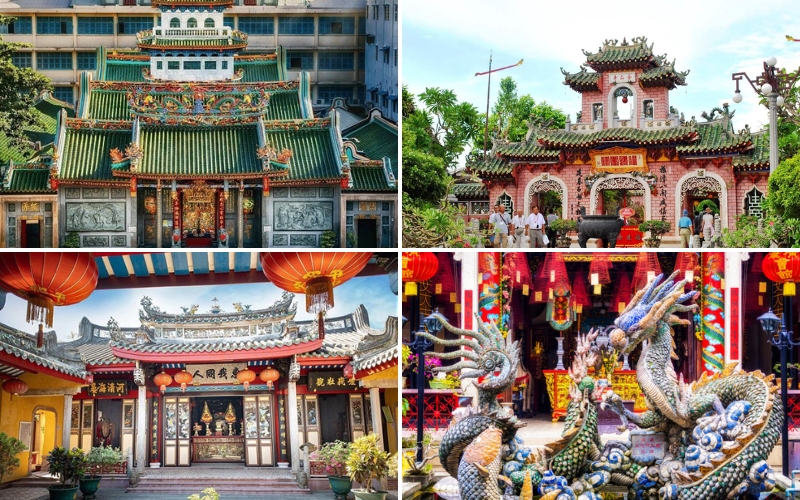
The majestic assembly halls of Hoi An, each has a different structure
Opening hours: 7:00 AM – 5:30 PM daily
Entrance fee: Included in the Hoi An Ancient Town entrance ticket (approximately $5)
Along the ancient streets of Hoi An, visitors are not only impressed by the mossy tiled roofs and golden walls, but also by the unique architectural works bearing the mark of Chinese culture – the Chinese assembly halls.
- Fujian Assembly Hall: This is the largest assembly hall in Hoi An, built in 1697 by Chinese people from Fujian. The temple is dedicated to Thien Hau Thanh Mau, the patron goddess of fishermen and merchants. The hall was built in the Chinese architectural style with curved domes, yin-yang tiles and sophisticated decorative details. This is also a popular destination for tourists to Hoi An ancient town who want to learn about Chinese culture and religion.
- Chaozhou Assembly Hall, also known as Am Bon Pagoda, is a spiritual place to worship the sea gods who control the wind and waves, praying for smooth sea trade and a prosperous life. The hall is also an elaborate architectural work with a delicately carved wooden frame, along with wooden decorative motifs carved according to folk legends. Not only that, the Trieu Chau Assembly Hall also has a number of unique ceramic relief works, demonstrating the ingenuity and talent of ancient artisans.
- Guangdong Assembly Hall: The hall was built in 1885 of the 18th century by a Chinese merchant. The Guangdong Assembly Hall was built with an architecture that harmoniously combines wood and stone. The decorative details are elaborately and elaborately carved, bearing the mark of Chinese culture.
- Trung Hoa Assembly Hall: It is also known as the Ngu Bang Assembly Hall, standing tall as a historical symbol in the heart of the old town. Through the ups and downs of history, it still retains almost intact its original architecture, with curved tiled roofs, mossy stone walls and sophisticated decorative details. In particular, this hall also preserves many valuable antiques, the most prominent of which is a 500-year-old iron nail placed solemnly in the middle of the yard.
Local tips:
- You can take photos in most areas, but avoid using flash near the altars and mute your camera. The courtyards are generally open spaces and are perfect for panoramic shots and detailed close-ups.
- You will appreciate your visit much more if you have a little understanding of the context. Each symbol, deity and ritual inside these halls has its own meaning, you can hire a local guide or join a short walking tour which is affordable and well worth it.
- Also, dress modestly (shoulders covered), perhaps bring a scarf or light jacket when entering the worship spaces, it is a small gesture, but a huge cultural appreciation.
Handicraft villages

Craft villages around Hoi An, where tradition lives on
Opening hours: Daily 8:00 AM – 5:30 PM
Entrance fee: Most are free but some charge a small fee of around $1.5
It would be a mistake to miss the Hoi An handicraft villages, including 12 typical traditional handicraft villages, and each handicraft village has its own unique beauty and is reproduced in the most authentic way. Some of the most famous handicraft villages include:
- Tra Que Vegetable Village: This is one of the most developed tourism villages in Hoi An. You will enjoy the fresh air and experience being a real vegetable farmer. Don’t forget to enjoy the cuisine here with delicious side dishes taken from the vegetable beds you just passed.
- Thanh Ha Pottery Village: Coming here, you will be immersed in the rustic, peaceful countryside space and also have the freedom to choose souvenirs for relatives and friends or experience making unique ceramic products yourself. Thanh Ha is also famous for its unique terracotta park, displaying Vietnamese architectural works and miniature ceramic wonders of the world.
- Kim Bong carpentry village: Coming to Kim Bong, visitors will be amazed by the wooden products of the craft village displayed in the open-space workshop. Visitors can easily visit, learn and even experience a few minutes as a “carpenter”.
- Phuoc Kieu bronze casting village: Coming to Phuoc Kieu bronze casting village, in addition to shopping for items and souvenirs, visitors also have the opportunity to directly participate in the production stages of bronze casting and watch artisans perform gong musical instruments, listen to the wonderful sounds emitted from these instruments. The sound creates the soul of Phuoc Kieu gongs.
Local tips:
- If you have time, combine a village tour with a bike ride through the countryside, which is peaceful, picturesque and offers a true glimpse into rural life.
- Bring cash in small bills for souvenirs or to donate to charity.
My Son sanctuary
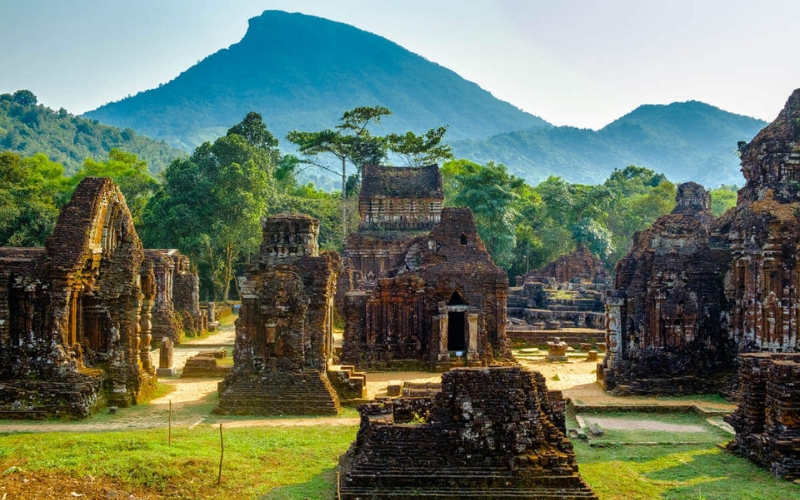
The ancient ruins of My Son Sanctuary
Address: Duy Phu, Duy Xuyen, Quang Nam
Opening hours: 6 AM – 5 PM daily
Ticket price:
- Foreigners: 150,000 VND
- Vietnamese: 100,000 VND
- Child under 16 years old: 30,000 VND
Along with Hoi An ancient town, My Son Sanctuary is also a UNESCO World Heritage Site, just a short drive from the city center. It was once the religious and political center of the Champa Kingdom, preserving important cultural and historical values of the ancient Champa Kingdom, contributing to the reputation of My Son Sanctuary and a famous tourist destination. The relic complex includes ancient temples with unique architecture, red brick towers dating back to the 4th century, scattered in a 2 km wide valley.
Aside from sightseeing, a highlight not to be missed is the live Cham dance performance, featuring traditional Siva-inspired rituals and music. These usually take place near the main temple area at 9:30am and 10:30am, so try to time your visit accordingly.
Local tips:
- Avoid going between 11am and early temple hours, as the sun is particularly harsh. I arrived around 7:30 am and found it peaceful, quiet and cool, with few other tourists around. Early morning also gives you a more peaceful experience before the tour groups arrive.
- These temples are sacred places, and many have been destroyed, so you should not climb them (even if you see others doing so). I also recommend covering your shoulders and knees – not required, but appreciated.
An Bang beach

An Bang Beach, one of the most beautiful beaches in the world
Address: An Bang Beach is located in Cam An Ward, about 3km northeast of Hoi An Ancient Town.
Opening hours: Always open (but early morning and late afternoon are the best times to enjoy the cool, clear weather).
Entrance fee: Free! You can pay 5,000–10,000 VND to park your motorbike at the beach entrance.
If you need a break from Hoi An, head to An Bang Beach, just 3km from the Ancient Town. Famous for its fine white sand and crystal clear waters, it has been named one of the 50 most beautiful beaches in the world. Unlike the more crowded beaches, An Bang remains quite peaceful and deserted, making it the perfect place to sunbathe, swim or sip a cocktail at a beachside cafe (I personally love Soul Kitchen for its sunset views and live music). Alternatively, you can enjoy a range of water sports such as kayaking, surfing or jet skiing. An Bang Beach is also a great place to watch spectacular sunrises and sunsets, with the sun glistening on the waves.
Local Tips:
- Weekends can be busier for locals, so for the most relaxing experience, try to go on a weekday.
- Bring cash for parking or if you are buying from the essential oils and small cafes as they will not accept card payments.
Hoi An night market
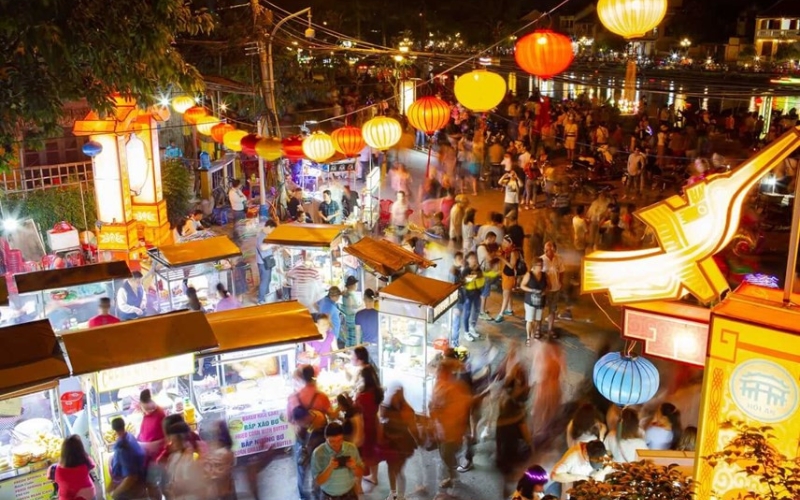
Hoi An night market, a vibrant spot filled with lanterns, local food, and handcrafted souvenirs
One of my favorite things to do in Hoi An, and something I always recommend to anyone visiting, is to spend an evening at the Hoi An Night Market. The Hoi An Night Market is one of the city’s most fascinating experiences, offering a mix of local culture, cuisine and handicrafts. The most famous market is located along Nguyen Hoang Street, just across the Thu Bon River, and is open from 5 PM to 11 PM.
With over 50 stalls lining the river, the market offers everything from handmade souvenirs, colorful lanterns to local street food. Don’t forget to try sweet snacks like coconut pancakes or grilled corn, and take home a lantern as a symbolic souvenir of your trip. The lit lanterns create a magical atmosphere, making it the perfect place to soak up the charm of Hoi An at night.
Local Tips:
- Don’t miss the crispy, sweet and delicious coconut pancakes made right in front of you. Also try the grilled corn with scallion oil, a simple yet addictive dish.
- Looking for a souvenir? Buy a folding lantern, it’s light, easy to fold and makes a great souvenir.
- For the best photos, come a little early, around 6:30 – 7:00 pm when the lanterns are lit but the market is not too crowded yet.
> > > Want to make the most of your visit after sunset? Head over to our detailed guide on What to Do at Hoi An Night Market for insider tips on food, shopping, and unforgettable moments under the lantern lights.
Cam Thanh coconut village
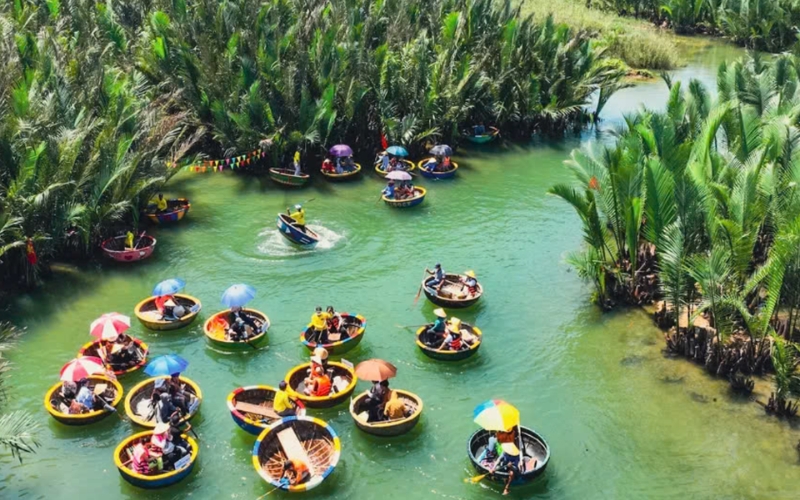
Cruising through Bay Mau Coconut Forest
Address: Group 2, Can Nhan Village, Cam Thanh Commune, Hoi An City, Quang Nam
Opening hours: 7 AM– 5 PM daily
Entrance ticket price:
- Adults: 30,000 VND/person
- Children from 5-9 years old: 15,000 VND/person
- Children under 5 years old: Free
Bay Mau Coconut Forest, also known as Cam Thanh Coconut Forest, is a popular eco-tourism spot. Located just outside the Old Quarter, the resort allows visitors to explore the palm-fringed waterways on traditional basket boats, guided by locals. I visited early in the morning, and honestly, it was the perfect place to escape the hustle and bustle of the Old Quarter. You board a traditional round basket boat and glide through narrow canals lined with coconut trees. As the boat drifts deeper into the forest, the hustle and bustle of the city fades away, replaced by the gentle rustling of leaves and the chirping of birds – a very relaxing feeling.
Along the way, the boatmen may treat you to a fun boat dance – they spin the boat in dizzying circles while maintaining perfect balance – it’s a crowd favorite! You will also see local fishermen throwing giant nets into the water and many guides will demonstrate how they make toys and trinkets from coconut leaves such as grasshoppers, rings or even fun sunglasses.
Local tips:
- Put your phone or electronics in a waterproof bag just in case it gets wet during the buffalo dance.
- Since this destination is outdoors, don’t forget to bring a hat, sunglasses and sunscreen. If you book through an agent, many will even provide you with a conical hat for free.
Cham islands
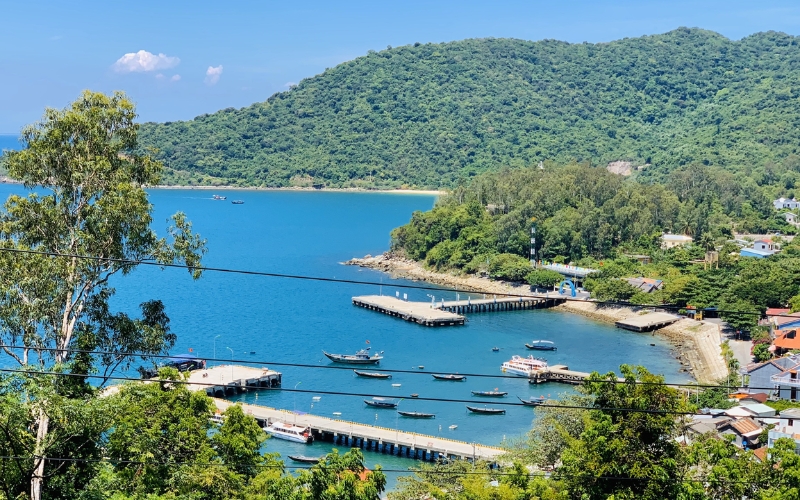
Scenic view of Cham Island from above
Address: Cu Lao Cham, Tan Hiep Commune, Hoi An City, Quang Nam Province
How to get there:
- Speed Boats depart daily from Cua Dai Pier (about 6–7 km from Hoi An Ancient Town).
- The first trip departs at 8 AM, the last trip returns at 2:30–3:30 PM
Opening hours:
- The island is open to tourists from March to September (dry season only).
- Overnight stays are possible, but please check the weather forecast carefully.
Entrance fee: 70,000 VND (including marine environmental protection fee).
To experience island life, take a speedboat to Cu Lao Cham, a group of eight small islands about 15 km off the coast. A UNESCO Biosphere Reserve, this is a nature lover’s paradise, with islands boasting crystal clear waters and a rich marine ecosystem with over 950 species of marine life. I recommend visiting Bai Chong if you’re looking for a quiet place to relax, or Bai Ong and Bai Huong if you’re looking for something more active and want to enjoy local seafood. There’s also a traditional fishing village worth exploring, where you can catch a glimpse of the island’s idyllic lifestyle.
Local tips:
- If it’s your first time, I recommend booking a half-day or full-day tour, which usually includes round-trip transportation, lunch, snorkeling gear and a guide.
- Snorkeling is a highlight here, especially around Hon Dai or Hon La. However, the coral here is fragile – don’t step on it and avoid touching the marine life.
- Many parts of the island have spotty or no mobile phone reception. Download offline maps and let someone know your plans if you are traveling alone.
- Boat services are canceled on windy or stormy days, especially from October to February. If you are traveling during low season, ask your hotel or operator to confirm boat schedules a day in advance.
> > > To truly uncover the charm of Hoi An beyond the postcard-perfect streets, let’s join our Hoi An tours, a great way to dive deeper into its history, culture, and hidden gems, whether on foot, by bike, or even by boat.
Some helpful tips from the experts for your Hoi An trip
Hoi An is not only a famous tourist destination of Vietnam, but also a place for you to really live slowly, immerse yourself in ancient beauty and unique culture. Here are some tips to help you have a smooth, memorable and complete journey.
- Choose the right time to travel: Located in central Vietnam, Hoi An has a tropical climate all year round, but there are also some bad weather times, especially during the rainy season from October to December. Plan to explore around February to April or August to October, when the weather is dry and not too hot, the sky is clear and sunny. You can check the lunar calendar (14th and 15th of the lunar month) to choose the days of the famous lantern festival.
- Get around Hoi An: as a famous tourist destination, there are many means of transport for you to choose from. If you travel a long distance and do not want to be hot, travel by taxi or book through applications such as Grab or Xanh SM, but always make sure the price if you take a local taxi. If you only move around the old town, the easiest and most convenient way is to walk, you will be able to explore every corner of the town. Renting a bicycle is also a popular choice for many tourists, especially when visiting tourist attractions outside the old town such as Tra Que Vegetable Village or An Bang Beach.
- Where to stay: Depending on your schedule, choose the right accommodation. Hotels in the old town will be quite convenient for traveling, but it can be quite noisy, especially on weekends and evenings. You can choose to stay in Cam Pho, Cam Nam, or Cam Thanh, only about 5-10 minutes by bike, providing quiet and gentle.
- Dress comfortably and politely: Hoi An is very comfortable for tourists, you can wear light and breathable clothes to suit the weather, don’t forget to bring a hat, umbrella and sunglasses if you are outside all day. Brightly colored clothes will be especially suitable for photos here, but you should pay attention to bring a scarf or thin jacket to cover your shoulders or knees if you visit temples or heritage destinations.
- Best places to take photos: Besides the famous tourist attractions, Hoi An also has many extremely beautiful photo spots, such as the Japanese Covered Bridge, Lantern-lit streets at night and the iconic old yellow walls from the French period.
- Try tailor-made clothing: Hoi An’s tailor shops are famous worldwide, with amazing quality and especially very fast sewing time, usually only 1-2 days. There are many shops in the old town, so check the prices at a few places, and clearly state your preferences and the design you want to make with the tailor to receive the most satisfactory product.
Hoi An is a destination that truly has something for everyone, where history, culture and natural beauty blend perfectly. With so many tourist attractions in Hoi An, Vietnam to explore, from ancient heritage sites to scenic spots and thrilling entertainment, you will never run out of things to do in this charming city. Hopefully, with the list of the most famous attractions in Hoi An above, you will have a wonderful trip in this heritage land.
Read more:
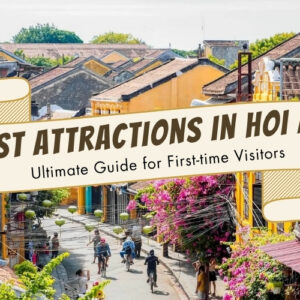
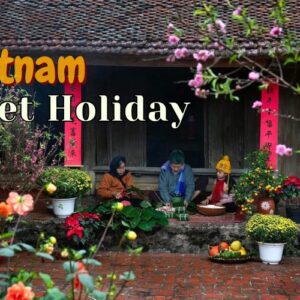


Should I go to An Bang beach on sunset or sunrise for rosy sky
Dear Madam,
Thank you for reaching out to us! Since An Bang beach faces east, it’s ideal for watchung the sunrise rather than the sunset. At dawn, the sun rises directly over the sea, casting soft, rosy hues across the sky and creating a peaceful, breathtaking view. Sunsets there can still be beautiful, with warm tones reflected in the clouds, but the sun sets behind the land, not over the ocean. So if you’re hoping for a classic rosy sky over the water, sunrise at An Bang is your best bet. Hope this helps!
Best regards,
IDC Travel Team.